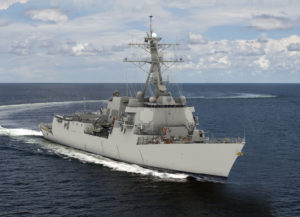Raytheon Technologies [RTX] started installing the first AN/SPY-6(V)1 radar on the Navy’s new Flight III Arleigh Burke
-class DDG-51 Aegis destroyer, the future USS Jack H. Lucas (DDG-125), the company said on Feb. 9.
The SPY-6, known as the Air and Missile Defense Radar (AMDR), aims to improve the operational performance for air and missile defense operations on Flight III destroyers. The size and requirements of the radar forced the Navy to modify the destroyers to be larger to house the radar systems as well as their power and cooling requirements.

DDG-125 is set to be the first Flight III destroyer. The AMDR consists of four radar arrays, a power system, cooler, and back-end processors to compute array signals. Raytheon advertises the new radar as 30 times more sensitive than the previous system on current Aegis destroyers.
The company delivered the first SPY-6 array for the Jack H. Lucas last July and at the time said the final one was expected to be delivered by October 2020 (Defense Daily, July 22, 2020).
Each individual array measures 14 by 14 feet and they are being installed on DDG-125 at shipbuilder Huntington Ingalls Industries’ [HII] shipyard in Pascagoula, Miss.
“As the future USS Jack Lucas takes shape, we are at the cusp of a new era for detection and discrimination of threats and decision-making at sea, SPY-6 will fill critical mission gaps and enable precision operations in jammed and cluttered environments like never before,” Capt. Jason Hall, program manager for Above-Water Sensors for the U.S. Navy’s Program Executive Office for Integrated Warfare Systems, said in a statement.
Raytheon said DDG-125 is on track to deliver in FY 2023 with the radar ready.
Scott Spence, Naval Radars director for Raytheon Missiles & Defense, told Defense Daily on Tuesday the Navy has indicated it plans to declare Flight III destroyer initial operational capability in 2024 and the SPY-6 radar will be included in that.
Spence also confirmed all four SPY-6 radar array installations are proceeding according to schedule and that the shipyard develops the plan and installs the arrays based on their shipbuilding requirements and schedule.
“The radars arrays are delivered to the shipyard fully calibrated and tested. Following installation and as ship systems such as power, cooling, and the Aegis Weapon System are made available by the shipyard, the radar is tested as part of the overall ship’s combat systems test plan,” Spence said.
He underscored installation itself is a fast process. It only takes about five hours from when the system is lifted from the delivery vehicle or ground and to when it is fastened into the ship’s framework.
“SPY-6 provides the Navy with unprecedented operational flexibility and readiness against a multitude of threats, and this milestone is a transformative step forward to placing unmatched technology into sailors’ hands,” Kim Ernzen, Naval Power vice president at Raytheon Missiles & Defense, said in a statement.
“From COVID-19 to hurricanes along the Gulf Coast, our partners cleared numerous hurdles to complete deliveries and keep this important part of the ship-build on schedule,” she added.
Raytheon is contracted to build 36 total SPY-6 arrays for nine Flight III DDG-51 destroyer AMDR shipsets over the next three years and are part of the low-rate initial production work. The radars will be delivered both to HII and the other DDG-51 shipbuilder, General Dynamics [GD] Bath Iron Works, in Bath, Maine.
Separately, last October the Navy’s Combat Systems Engineering Development Site (CSEDS) in Moorestown, N.J., received the AMDR to test it and provide lessons learned in a controlled environment and correct any issues before the radar is integrated and deployed on destroyers (Defense Daily, Oct. 8, 2020).
Spence said the SPY-6 delivered to CSEDS is in support of the Navy’s software development of the Aegis Baseline 10 combat system “and does not affect shipboard installation requirements.”